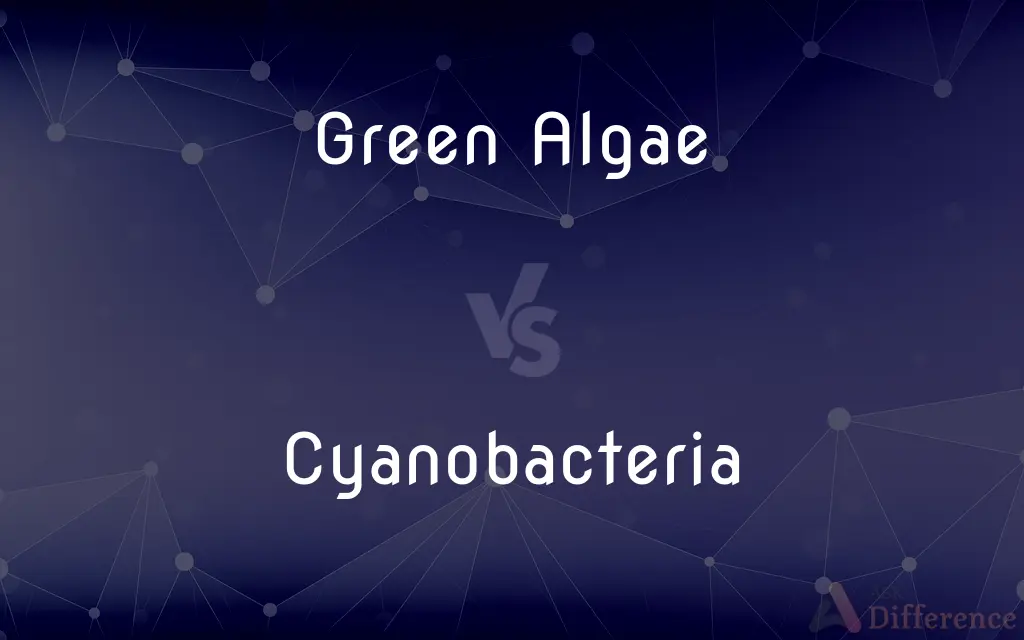Green Algae vs. Cyanobacteria — What's the Difference?
By Tayyaba Rehman — Published on January 13, 2024
Green algae are eukaryotic, photosynthetic organisms, while cyanobacteria are prokaryotic, photosynthetic bacteria.

Difference Between Green Algae and Cyanobacteria
Table of Contents
ADVERTISEMENT
Key Differences
Green algae are eukaryotic organisms belonging to the kingdom Plantae, characterized by their green color due to chlorophyll. They can be found in various aquatic and terrestrial environments. In contrast, cyanobacteria, also known as blue-green algae, are prokaryotic microorganisms found in diverse habitats, including extreme conditions.
Both green algae and cyanobacteria perform photosynthesis but differ in their cellular structure. Green algae have a defined nucleus and other membrane-bound organelles, while cyanobacteria lack these features. Cyanobacteria's photosynthetic apparatus is embedded directly in their cytoplasmic membrane.
Reproduction in green algae can be both sexual and asexual, involving complex life cycles. Cyanobacteria primarily reproduce asexually through binary fission, although some exhibit primitive forms of sexual reproduction. This difference highlights the evolutionary divergence between these two groups.
Green algae are an important part of aquatic food chains and contribute to oxygen production. Cyanobacteria play a crucial role in nitrogen fixation, converting atmospheric nitrogen into forms usable by plants. Both groups have ecological and environmental significance.
In terms of human use, some species of green algae are used as food supplements, like Spirulina, which is actually a type of cyanobacteria mistakenly categorized as algae. Both green algae and cyanobacteria have potential in biotechnology and biofuel production.
ADVERTISEMENT
Comparison Chart
Cellular Structure
Eukaryotic with defined nucleus and organelles
Prokaryotic without defined nucleus or organelles
Photosynthetic Pigments
Primarily chlorophyll
Chlorophyll and phycobilins
Habitat
Aquatic and terrestrial environments
Diverse, including extreme conditions
Reproduction
Sexual and asexual
Mainly asexual, binary fission
Role in Environment
Part of food chains, oxygen production
Nitrogen fixation, oxygen production
Compare with Definitions
Green Algae
Aquatic, photosynthetic eukaryotic organisms with green chlorophyll.
The pond was covered with a layer of green algae.
Cyanobacteria
Prokaryotes capable of nitrogen fixation.
Cyanobacteria are crucial for enriching soil nutrients.
Green Algae
Diverse group within the kingdom Plantae.
Some green algae species are used in aquariums for decoration.
Cyanobacteria
Oxygen-producing, aquatic microorganisms.
Cyanobacteria were among the first organisms to produce oxygen on Earth.
Green Algae
Eukaryotes found in fresh and marine waters.
Green algae contribute significantly to the ecosystem's oxygen.
Cyanobacteria
Bacteria with photosynthetic capabilities.
Cyanobacteria can survive in extreme environments, like hot springs.
Green Algae
Oxygen-producing photosynthetic organisms.
Green algae play a vital role in aquatic food webs.
Cyanobacteria
Photosynthetic, prokaryotic organisms, also known as blue-green algae.
Cyanobacteria blooms can cause problems in freshwater bodies.
Green Algae
Plant-like organisms with chloroplasts and a cell wall.
Green algae can be single-celled or form large colonies.
Cyanobacteria
Ancient, diverse group of bacteria.
Some cyanobacteria form symbiotic relationships with plants.
Cyanobacteria
Any of various photosynthetic bacteria of the phylum Cyanobacteria that are generally blue-green in color and are widespread in marine and freshwater environments, with some species capable of nitrogen fixation. Also called blue-green alga, blue-green bacterium.
Cyanobacteria
Plural of cyanobacterium.
Cyanobacteria
Predominantly photosynthetic prokaryotic organisms containing a blue pigment in addition to chlorophyll; occur singly or in colonies in diverse habitats; important as phytoplankton
Common Curiosities
What are green algae?
Green algae are eukaryotic, photosynthetic organisms found in aquatic and terrestrial habitats.
What are cyanobacteria?
Cyanobacteria are prokaryotic, photosynthetic microorganisms, also known as blue-green algae.
What colors can cyanobacteria be?
Cyanobacteria can be blue-green, green, black, or red, depending on their pigments.
What color are green algae?
Green algae are typically green due to the presence of chlorophyll.
How do cyanobacteria reproduce?
Cyanobacteria primarily reproduce asexually through binary fission.
Where can green algae be found?
Green algae are found in freshwater, marine environments, and on moist land.
Can cyanobacteria survive in harsh conditions?
Yes, cyanobacteria can thrive in extreme environments, including hot springs and deserts.
Do cyanobacteria have a nucleus?
No, as prokaryotes, cyanobacteria lack a defined nucleus.
How do green algae reproduce?
Green algae reproduce both sexually and asexually.
Are green algae used for human consumption?
Yes, some green algae are used as food supplements and in health products.
Are cyanobacteria harmful to humans?
Some cyanobacteria produce toxins that can be harmful to humans and animals.
Can both green algae and cyanobacteria produce oxygen?
Yes, both groups are capable of oxygenic photosynthesis.
What is the ecological role of cyanobacteria?
Cyanobacteria play a key role in nitrogen fixation and oxygen production.
Are green algae multicellular or unicellular?
Green algae can be either multicellular or unicellular.
Can green algae cause water blooms?
Yes, some green algae can form blooms, but cyanobacterial blooms are more common.
Share Your Discovery

Previous Comparison
Product vs. Process
Next Comparison
Heterosis vs. Inbreeding DepressionAuthor Spotlight
Written by
Tayyaba RehmanTayyaba Rehman is a distinguished writer, currently serving as a primary contributor to askdifference.com. As a researcher in semantics and etymology, Tayyaba's passion for the complexity of languages and their distinctions has found a perfect home on the platform. Tayyaba delves into the intricacies of language, distinguishing between commonly confused words and phrases, thereby providing clarity for readers worldwide.
















































